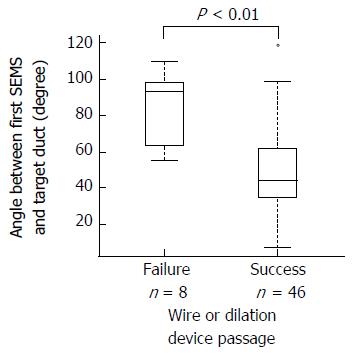Copyright
©The Author(s) 2017.
World J Gastroenterol. Sep 14, 2017; 23(34): 6273-6280
Published online Sep 14, 2017. doi: 10.3748/wjg.v23.i34.6273
Published online Sep 14, 2017. doi: 10.3748/wjg.v23.i34.6273
Figure 4 Influence of the angle between the target biliary duct stricture and the first retained self-expandable metallic stent on wire or dilation device passage.
The angle between the target biliary stricture and the first implanted self-expandable metallic stent in patients without wire or dilation catheter passage was significantly greater than the corresponding angle in the patients with wire or dilation catheter passage [93.0 degree (55-109.3) vs 44.2 degree (7-119.0), P < 0.01, median (range)].
- Citation: Sugimoto M, Takagi T, Suzuki R, Konno N, Asama H, Watanabe K, Nakamura J, Kikuchi H, Waragai Y, Takasumi M, Sato Y, Hikichi T, Ohira H. Predictive factors for the failure of endoscopic stent-in-stent self-expandable metallic stent placement to treat malignant hilar biliary obstruction. World J Gastroenterol 2017; 23(34): 6273-6280
- URL: https://www.wjgnet.com/1007-9327/full/v23/i34/6273.htm
- DOI: https://dx.doi.org/10.3748/wjg.v23.i34.6273









